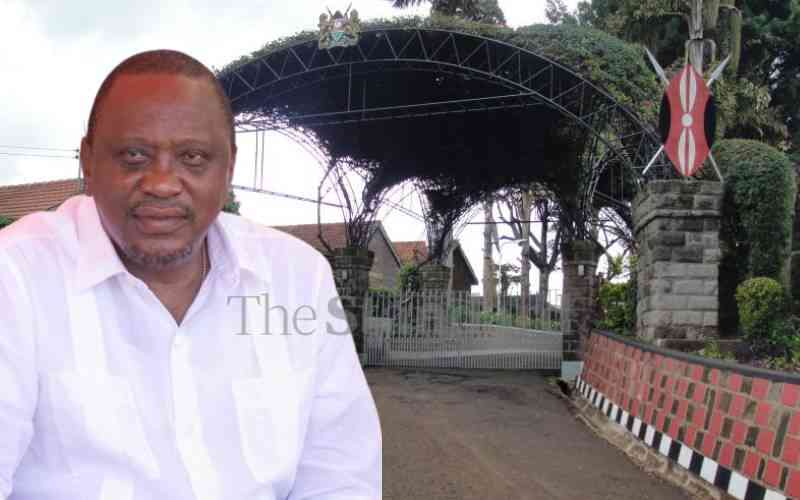Mashujaa Day (October 20) is a date of great political and national significance in Kenya. It is a day to reflect on how far the country has come since independence, and to celebrate those who struggled for the country's freedom from the colonial masters.
But unknown to many, in a quiet village West of Eldama Ravine town lies a beautiful, old, timber house; a testament of the country's rich history of the much-celebrated day.
The house looks different from the dozen others around it, and has remained strong for over a century. It is here that the founding President, the late Mzee Jomo Kenyatta, took refuge in the wake of the 1952 Mau Mau crackdown.
"Without this house, the eagerly awaited celebrations would have been incomplete. This place should be recognised even by the current President, and as a family, we request him to make a visit to see for himself," says 58-year-old Moses Kerich, a resident of Arama village.
The peasant farmer said he was privileged to have lived in the same house where Mzee Kenyatta slept.
"The founding President slept here for four days and shared food with my late father but unfortunately, he was arrested the fifth day as he fled aboard a train," he explained.
The five-roomed, purely wooden store-like house has a rich history that has not been told before; only villagers have great respect for it and its successive occupants.
Mr Kerich said before Kenyatta was arrested and locked up at Kapenguria, elders from the Lembus community received him as he fled from the cruel hands of powerful colonial masters in parts of Central Kenya.
Initially, Kenyatta is said to have sought refuge at former paramount chief Joel Chemirmir's house near Eldama Ravine town but was forced to flee to one Arap Kipsalgong's house, deep in the expansive Lembus Forest after he deemed the place insecure.
But again, he had to flee from Mr Kipsalgong's home, as the marauding African guards trailed him.
For successive days, he addressed the Mau Mau veterans while hiding in the expansive and thick Lembus Forest but at night, he would retreat to the house, and specifically the Kitchen, where he slept alone.
"Security guards working for the colonial masters only concentrated onb the bigger house and that is what saved Kenyatta from being arrested," narrated Kerich, who said his father also risked being punished for hiding a fugitive.
Kerich said the house was built by a colonialist who was among the white settlers in Eldama Ravine but when he left the country in the early 1940s, he left the house to his father, who was his porter.
He says his father, the late Kiprop Kerich, was a friend to Kenyatta and when word went round that colonial intelligence officers were zeroing in on the village, he instructed Kenyatta to hide inside a telephone booth-like room in an upright position during day time before elders declared the vicinity safe enough for him to be relocated.
"The small room saved the founding President from the merciless hand of the colonialists during day time but he was relocated each night to the Kitchen," explained Kerich, pointing at a room that once served as an armoury for the white settler.
Stay informed. Subscribe to our newsletter
Kerich said his father worked as an official of the Kenya African Union, and would frequently communicate with Kenyatta. He was also a businessman who bought the first lorry in the area.
After the tension eased, and the surrounding declared safe by the elders, Mzee Kerich sneaked Kenyatta out of the village and drove 50km to Maji Mazuri Railway Station where he caught a train to Central Province but he was unfortunately arrested at Londiani Railway Station and driven to Kapenguria.
"But sadly, nobody has come out to recognise such efforts. My father risked his life alongside that of his family to fight colonialists. Time has come for the country to recognise the country's heroes like my father," he said.
Kenyatta taken for trial at Kapenguria in 1953, charged with managing Mau mau movement. This was after Sir Evelyn Baring, the newly appointed Governor of Kenya, had declared the State of Emergency.
The accused were labelled as the 'Kapenguria Six' and they included Kenyatta, Kungu Karumba, Fred Kubai, Paul Ngei, Bildad Kaggia and Ramogi Achieng' Oneko.
Kerich has tried several times to renovate the building and replace the wooden roofs with iron sheets but the locals and Lembus elders have prevented him from succeeding.
Lembus Council of Elders Chairman Joseph Leboo explained that the house is a rich part of Kenya's heritage and as such, should be preserved for future generations.
"We are privileged that deep in this village, unknown to many, Kenyatta escaped the colonialist's handcuffs. We are part of history," says Erick Ngeno, a resident.
However, the fine architectural handiwork now nears its sunset days as several sections of the building, among them a fireplace are falling apart.
 The Standard Group Plc is a
multi-media organization with investments in media platforms spanning newspaper
print operations, television, radio broadcasting, digital and online services. The
Standard Group is recognized as a leading multi-media house in Kenya with a key
influence in matters of national and international interest.
The Standard Group Plc is a
multi-media organization with investments in media platforms spanning newspaper
print operations, television, radio broadcasting, digital and online services. The
Standard Group is recognized as a leading multi-media house in Kenya with a key
influence in matters of national and international interest.
 The Standard Group Plc is a
multi-media organization with investments in media platforms spanning newspaper
print operations, television, radio broadcasting, digital and online services. The
Standard Group is recognized as a leading multi-media house in Kenya with a key
influence in matters of national and international interest.
The Standard Group Plc is a
multi-media organization with investments in media platforms spanning newspaper
print operations, television, radio broadcasting, digital and online services. The
Standard Group is recognized as a leading multi-media house in Kenya with a key
influence in matters of national and international interest.










